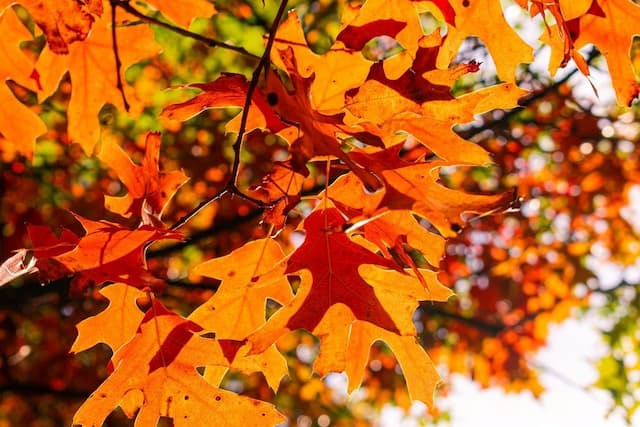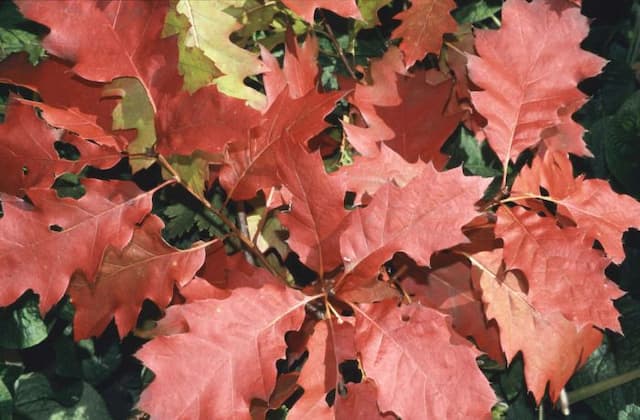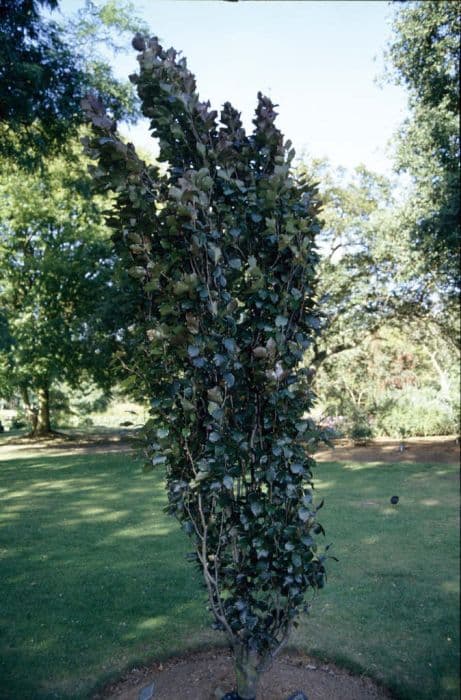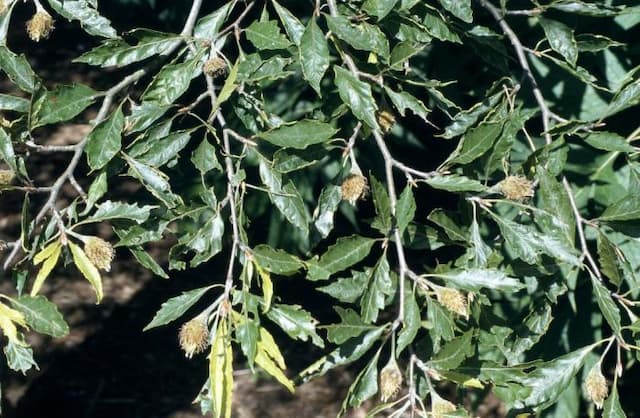Sweet chestnut Castanea sativa

ABOUT
The European chestnut, often referred to simply as the chestnut, is a deciduous tree known for its distinctive appearance. The leaves of the chestnut are oblong and lance-shaped, characterized by their sharply toothed edges which give a serrated look. Typically, the leaves are dark green and glossy on the top, with a paler underside that might feel slightly hairy to the touch. The tree blooms with long, catkin-like flowers. The male flowers are arranged in elongated clusters, which are usually yellowish and pendulous, contributing to a visually striking display during the flowering season. The female flowers are found at the base of these clusters and are less conspicuous. As for the bark, it is deeply furrowed, providing a rugged texture, and tends to be grey-brown in color. Over time, the bark can become quite thick and deeply grooved. The chestnuts themselves are notable for being encased in a spiky husk, which splits open as the nuts mature. Inside these husks are the shiny brown nuts, often flat on one side and rounded on the other, known for their sweet, starchy flesh. These nuts are an important food source for many types of wildlife and are also harvested for human consumption. The chestnut tree's appearance throughout the seasons, from its summer foliage to autumn's golden-brown leaves and winter's stark silhouette, makes it a distinctive and recognizable tree in various landscapes.
About this plant
 Names
NamesFamily
Fagaceae.
Synonyms
European Chestnut, Sweet Chestnut, Spanish Chestnut, Portuguese Chestnut.
Common names
Castanea vesca, Castanea vulgaris, Fagus castanea.
 Toxicity
ToxicityTo humans
The most common name for Castanea sativa is the European chestnut. This plant is not considered poisonous to humans. In fact, the nuts of this plant, known as chestnuts, are edible and consumed in various cuisines around the world. There are no well-documented cases of toxicity in humans from ingesting parts of the European chestnut tree itself. However, like with any food item, individual allergies to chestnuts can exist, which might cause adverse reactions in sensitive individuals. These could include typical food allergy symptoms such as itching, hives, or gastrointestinal distress.
To pets
The European chestnut is not considered toxic to pets either. Pets can consume the nuts of the European chestnut without expected toxicity. However, pet owners should be cautious as the nuts can pose a choking hazard or cause intestinal blockages if ingested whole or in large quantities. If a pet has an underlying health condition such as kidney or gastrointestinal disease, ingesting chestnuts might exacerbate their condition, so it's always best to consult with a veterinarian. Regular consumption of nuts for pets is not generally recommended due to their high fat content, which can lead to obesity and associated health issues.
 Characteristics
CharacteristicsLife cycle
Perennials
Foliage type
Deciduous
Color of leaves
Green
Flower color
Green
Height
50-100 feet (15-30 meters)
Spread
50-70 feet (15-21 meters)
Plant type
Tree
Hardiness zones
5
Native area
Europe
Benefits
 General Benefits
General Benefits- Edible Nuts: The European chestnut provides nutritious nuts that are rich in carbohydrates and can be roasted, boiled, or used in various recipes.
- Timber Production: The wood of the European chestnut is durable and rot-resistant, making it valuable for furniture, fencing, and construction.
- Wildlife Habitat: The tree offers food and shelter for a variety of wildlife, including squirrels, deer, and wild boars.
- Shade and Ornamental Use: The European chestnut is often planted for its aesthetic appeal and its ability to provide ample shade due to its large canopy.
- Soil Improvement: The tree can improve soil quality by adding organic matter through leaf litter and providing a robust root system that stabilizes the soil.
- Cultural Significance: The European chestnut has traditional importance in many cultures, particularly in Europe, where chestnut festivals celebrate the harvest.
- Biodiversity Support: As part of a mixed forest, the tree contributes to plant diversity, offering a habitat for various fungi and plant species that live in symbiosis with it.
- Carbon Sequestration: Like other trees, the European chestnut absorbs carbon dioxide, helping to mitigate climate change by sequestering carbon in its biomass.
 Medical Properties
Medical Properties- Antioxidant activity: The leaves of the sweet chestnut (Castanea sativa) have been found to contain compounds with antioxidant properties.
- Anti-inflammatory effects: Sweet chestnut extracts may possess anti-inflammatory effects, potentially beneficial in reducing inflammation.
- Astringent: The bark of the sweet chestnut tree has traditionally been used for its astringent properties, which can help to tighten tissues and reduce secretions.
- Antispasmodic: Some traditional uses of sweet chestnut include treatments for coughs and other respiratory issues due to its antispasmodic properties.
- Expectorant: It has been used to aid in the relief of coughs and to help expel mucus from the respiratory system due to its expectorant quality.
- Wound healing: Historically, sweet chestnut leaves have been applied externally to help in the healing of wounds.
 Air-purifying Qualities
Air-purifying QualitiesThis plant is not specifically known for air purifying qualities.
 Other Uses
Other Uses- Tanning Leather: The high tannin content in European chestnut bark was historically used in the tanning process to convert animal hides into leather.
- Woodworking: European chestnut wood is valued for its workability and durability, making it suitable for fine furniture, cabinetry, and interior joinery.
- Fencing and Outdoor Structures: Due to its rot-resistant properties, European chestnut wood is often used for outdoor applications such as fencing, gates, and garden pergolas.
- Ink Production: The tannins extracted from the bark of the European chestnut can also be used to make natural brown-colored ink.
- Animal Feed: The leaves and branches of the European chestnut tree can be used as fodder for livestock, particularly goats and sheep.
- Flour Substitute: Chestnuts from the European chestnut tree can be dried and ground to produce a gluten-free flour used for baking and cooking.
- Biofuel: The biomass from the European chestnut tree, including wood and nutshells, can be used for energy production in the form of biofuel.
- Dye for Fabrics: The natural tannins and colorants in the bark and leaves of the European chestnut can be used to dye textiles and yarns.
- Smoking Food: Wood chips from the European chestnut tree are used in smoking meats and fish to impart a unique flavor.
- Waterproofing Agent: Tannins from the tree bark have been used in traditional methods for waterproofing fabrics and ropes.
Interesting Facts
 Feng Shui
Feng ShuiThe European chestnut is not used in Feng Shui practice.
 Zodiac Sign Compitability
Zodiac Sign CompitabilityThe European chestnut is not used in astrology practice.
 Plant Symbolism
Plant Symbolism- Fertility and Abundance: The abundance of nuts produced by the Sweet Chestnut tree symbolizes fertility and abundance, reflecting the tree's generous and life-sustaining nature.
- Strength and Endurance: As a sturdy and long-lived tree, the Sweet Chestnut represents strength and the ability to endure hardship, standing strong through the tests of time.
- Provision and Nourishment: Throughout history, the Sweet Chestnut has been an important food source, symbolizing provision and nourishment for many cultures.
- Longevity: Because Sweet Chestnut trees can live for many centuries, they have become symbols of longevity and perseverance.
- Healing: With reputed medicinal properties, parts of the Sweet Chestnut tree are thought to symbolize healing and the restoration of health.
 Water
WaterThe Sweet Chestnut (Castanea sativa) should be watered deeply and thoroughly, allowing the soil to be moist but never waterlogged. Typically, young trees require watering once a week, ensuring that they receive at least 1 to 1.5 gallons of water, particularly during dry spells. Mature trees are more drought-tolerant and may require less frequent watering, but during prolonged periods without rain, they may need supplemental water every two to three weeks. It's important to avoid overhead watering to prevent fungal diseases, focusing on soil-level irrigation instead. Always check the soil moisture before watering by feeling the soil; if the top 2 to 4 inches of soil are dry, it's time to water.
 Light
LightThe Sweet Chestnut thrives best in full sunlight, which means it should receive at least six hours of direct sunlight per day. It is ideal to plant it in a location where it is exposed to unfiltered sunlight for most of the day. These trees can tolerate some light shade, but their growth and fruiting capacity are optimal in full sun.
 Temperature
TemperatureThe Sweet Chestnut is hardy and can tolerate a range of temperatures; however, it grows best in conditions that average between 50°F and 75°F. This tree can withstand winter cold down to around -20°F but younger trees may need protection at these lower temperatures. The ideal growing temperature range for active growth and nut production is a warm summer with temperatures regularly above 70°F.
 Pruning
PruningPruning the Sweet Chestnut is necessary to maintain tree health, shape, and to enhance nut production. Remove dead or diseased wood, thin out crowded branches, and shape the tree during the dormant season, preferably in late winter before the buds swell. Pruning should be carried out every few years to ensure optimal sunlight penetration and air circulation within the canopy, which helps reduce disease risk.
 Cleaning
CleaningNot needed
 Soil
SoilThe Sweet Chestnut (Castanea sativa) thrives best in a well-draining, loamy soil with a slightly acid to neutral pH of 4.5 to 7.0. A mix of garden soil, compost, and perlite or coarse sand is ideal to ensure good drainage while providing adequate nutrients.
 Repotting
RepottingSweet Chestnuts do not commonly grow in containers as they are large trees, but if you must, young Sweet Chestnut trees should be repotted every 2 to 3 years into larger pots until they can be planted outdoors.
 Humidity & Misting
Humidity & MistingSweet Chestnut trees are adaptable but prefer moderate humidity levels. They do well in outdoor environments where humidity naturally fluctuates, without the need for specific humidity control.
 Suitable locations
Suitable locationsIndoor
Sweet Chestnuts are ill-suited for indoor growth due to their size.
Outdoor
Plant Sweet Chestnut in deep soil, full sun, and water regularly.
Hardiness zone
5-7 USDA
 Life cycle
Life cycleCastanea sativa, commonly known as the sweet chestnut, begins its life cycle with seed germination where the chestnut seed sprouts and develops a root system and a shoot that grows towards the light. The seedling stage follows, where it establishes true leaves and begins photosynthesis. As it matures into a sapling, the plant develops a woody stem and branches, forming the typical structure of a tree. The sweet chestnut reaches the juvenile stage, where it grows in height and girth but has not yet reached sexual maturity. After several years, the sweet chestnut enters the reproductive stage, flowering in the summer with long, yellowish catkins which are wind-pollinated, leading to the production of the characteristic spiny fruits that contain the edible chestnuts. The tree then continues to live as a mature adult, capable of reproduction for many years before eventually senescing and dying.
 Propogation
PropogationPropogation time
Late winter-early spring
The most popular method of propagating the European chestnut, Castanea sativa, is through seed germination. The best time to collect chestnuts for propagation is in the fall when they are ripe and fall to the ground. Fresh chestnuts should be planted soon after collection as their viability decreases with storage. They are typically sown 1 to 2 inches deep in well-drained soil and spaced about 10 to 12 inches apart. It's important to protect the seeds from predators, such as rodents, and to keep the soil moist. Germination occurs in the spring and seedlings can eventually be transplanted to their permanent location once they have grown strong enough to survive the move.









